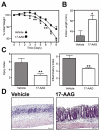Inhibition of N-terminal ATPase on HSP90 attenuates colitis through enhanced Treg function
- PMID: 23321985
- PMCID: PMC3748235
- DOI: 10.1038/mi.2012.134
Inhibition of N-terminal ATPase on HSP90 attenuates colitis through enhanced Treg function
Abstract
Inflammatory bowel disease (IBD) is a chronic inflammatory condition thought to reflect a failure of the enteral immune system to adequately regulate itself. Inflammatory stress drives upregulation of heat-shock proteins (HSPs), including the pro-inflammatory chaperone, HSP90. This protein sequesters the transcription factor, heat-shock factor 1 (HSF1) in the cytoplasm preventing transcription of a number of anti-inflammatory proteins. We hypothesized that inhibition of HSP90 would exert an anti-inflammatory effect and thereby attenuate intestinal inflammation in murine models of IBD. Inhibition of HSP90 with 17-allylaminogeldanamycin (17-AAG) reduced inflammation in acute dextran sodium sulfate and chronic CD45RB(High) colitis models coinciding with increased interleukin (IL)-10 production in the colon. Regulatory T cells (Tregs) from mice treated with 17-AAG demonstrated significantly greater suppressive capacity in vitro abolished in HSF1-/- or IL-10-/- cells. Finally, Tregs treated with 17-AAG exhibited increased nuclear localization of HSF1 with resultant upregulation of HSF1 response genes, including HSP70, HSP90 and IL-10.
Figures









Similar articles
-
Molecular stress-inducing compounds increase osteoclast formation in a heat shock factor 1 protein-dependent manner.J Biol Chem. 2014 May 9;289(19):13602-14. doi: 10.1074/jbc.M113.530626. Epub 2014 Apr 1. J Biol Chem. 2014. PMID: 24692538 Free PMC article.
-
Inhibition of heat shock protein (molecular weight 90 kDa) attenuates proinflammatory cytokines and prevents lipopolysaccharide-induced liver injury in mice.Hepatology. 2012 May;55(5):1585-95. doi: 10.1002/hep.24802. Epub 2012 Mar 18. Hepatology. 2012. PMID: 22105779 Free PMC article.
-
Distinct roles of intracellular heat shock protein 70 in maintaining gastrointestinal homeostasis.Am J Physiol Gastrointest Liver Physiol. 2018 Feb 1;314(2):G164-G178. doi: 10.1152/ajpgi.00208.2017. Epub 2017 Oct 19. Am J Physiol Gastrointest Liver Physiol. 2018. PMID: 29051186 Free PMC article.
-
Targeted inhibition of heat shock protein 90 suppresses tumor necrosis factor-α and ameliorates murine intestinal inflammation.Inflamm Bowel Dis. 2014 Apr;20(4):685-94. doi: 10.1097/01.MIB.0000442839.28664.75. Inflamm Bowel Dis. 2014. PMID: 24552830 Free PMC article.
-
Hsp90 in Cancer: Transcriptional Roles in the Nucleus.Adv Cancer Res. 2016;129:89-106. doi: 10.1016/bs.acr.2015.08.002. Epub 2015 Oct 12. Adv Cancer Res. 2016. PMID: 26916002 Free PMC article. Review.
Cited by
-
Hybrid Nanoparticles Modified by Hyaluronic Acid Loading an HSP90 Inhibitor as a Novel Delivery System for Subcutaneous and Orthotopic Colon Cancer Therapy.Int J Nanomedicine. 2021 Mar 2;16:1743-1755. doi: 10.2147/IJN.S275805. eCollection 2021. Int J Nanomedicine. 2021. PMID: 33688189 Free PMC article.
-
The Functions and Therapeutic Potential of Heat Shock Proteins in Inflammatory Bowel Disease-An Update.Int J Mol Sci. 2019 Oct 26;20(21):5331. doi: 10.3390/ijms20215331. Int J Mol Sci. 2019. PMID: 31717769 Free PMC article. Review.
-
Epidermolysis Bullosa Acquisita-Current and Emerging Treatments.J Clin Med. 2023 Feb 1;12(3):1139. doi: 10.3390/jcm12031139. J Clin Med. 2023. PMID: 36769788 Free PMC article. Review.
-
Gambogic acid targets HSP90 to alleviate DSS-induced colitis via inhibiting the necroptosis of intestinal epithelial cells.Front Pharmacol. 2025 May 19;16:1586705. doi: 10.3389/fphar.2025.1586705. eCollection 2025. Front Pharmacol. 2025. PMID: 40458801 Free PMC article.
-
Mutations Y493G and K546D in human HSP90 disrupt binding of celastrol and reduce interaction with Cdc37.FEBS Open Bio. 2016 May 25;6(7):729-34. doi: 10.1002/2211-5463.12081. eCollection 2016 Jul. FEBS Open Bio. 2016. PMID: 27398312 Free PMC article.
References
-
- Singh B, et al. Control of intestinal inflammation by regulatory T cells. Immunol Rev. 2001;182:190–200. - PubMed
-
- Mottet C, Uhlig HH, Powrie F. Cutting edge: cure of colitis by CD4+CD25+ regulatory T cells. J Immunol. 2003;170:3939–3943. - PubMed
-
- De AK, Kodys KM, Yeh BS, Miller-Graziano C. Exaggerated human monocyte IL-10 concomitant to minimal TNF-alpha induction by heat-shock protein 27 (Hsp27) suggests Hsp27 is primarily an antiinflammatory stimulus. J Immunol. 2000;165:3951–3958. - PubMed
Publication types
MeSH terms
Substances
Grants and funding
LinkOut - more resources
Full Text Sources
Other Literature Sources
Molecular Biology Databases

